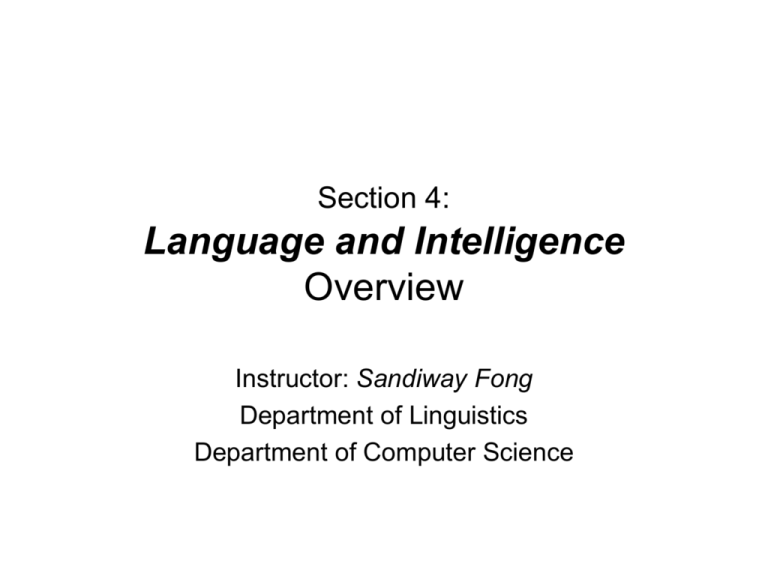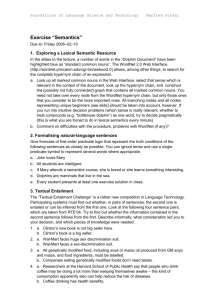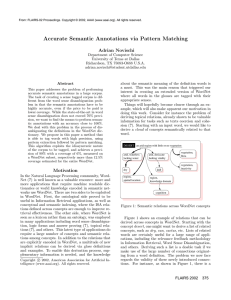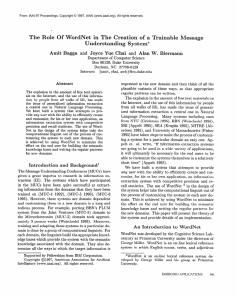lecture0 - University of Arizona
advertisement

Section 4: Language and Intelligence Overview Instructor: Sandiway Fong Department of Linguistics Department of Computer Science Course Contents • Two Parts 1. Computing with Linguistic Theory – – 2. How can we analyze sentences on a computer on the basis of universal principles of grammar? Introduction to systems of linguistic principles and language parameters Computing Semantic Relations between Words and Concepts – – What can we do with a computer and a semantic network of words? Find connections between words, recover latent semantic relations and deduce commonalities between words Course Contents • Two Homework Exercises – one for each part of the course • – grading: 50/50 split both involve use of specific computer tools developed by the instructor • • freely downloadable log in to computational linguistics lab machines – • tools run on MacOS X and PCs – – • • or use your own computer Linux directly Windows via X-Windows client software little (to no) coding involved ability to read code is a plus – programming language is Prolog (logic) Part 1 • Computing with Linguistic Theory – Universal Grammar (UG) • language is special – idea there is a “language faculty” in the human mind • (Chomsky, Knowledge of Language, 1986) – general theory of a framework of principles and elements common to attainable human languages – language faculty is a language acquisition device, an innate component of the human mind, containing UG that yields a particular language through interaction with presented experience – Acquisition • LouAnn Gerkin (guest lecture) – We will explore a computer implementation of a UG • a common set of syntactic principles • systematic variation across particular languages encoded by language parameters Part 1 • Computing with Linguistic Theory – PAPPI Demo language: Turkish input: sentence principles: constraints output: syntactic logical form principles: generators Part 1 • Computing with Linguistic Theory – Background Reading • Motivation and Philosophy – Knowledge of Language, N. A. Chomsky. Praeger 1986. » Ch1: Knowledge of Language as a Focus of Inquiry (1–14) • Introductory Technical Material – Chomsky's Universal Grammar: An Introduction. V.J. Cook. Blackwell 1988. – A Course in GB Syntax. H. Lasnik. MIT Press 1988. • PAPPI – http://dingo.sbs.arizona.edu/~sandiway/pappi/ Part 2 • Computing Semantic Relations between Words and Concepts – We will use WordNet to compute linguistically-motivated relations between words – WordNet • English WordNet (Princeton) is a hand-compiled network of 200,000 word senses (meanings) with 600,000 links – note: there are also WordNets for many other languages • Princeton WordNet website: – http://www.cogsci.princeton.edu/~wn – “WordNet is an on-line lexical reference system whose design is inspired by current psycholinguistic theories of human lexical memory. English nouns, verbs, adjectives and adverbs are organized into synonym sets, each representing one underlying lexical concept. Different relations link the synonym sets.” Part 2 • Computing Semantic Relations between Words and Concepts – Quick Example: • What is the relationship between concepts mend and tear? • Consider the sentence: – John mended the torn dress » example from Event-based Models of Change and Persistence in Language (Pustejovsky, 2000) • Contrast with: – John mended the red dress • Answer: – After the completion of the “mending” event, we would expect the dress to be no longer torn in John mended the torn dress • i.e. there is semantic opposition between the concepts mend and tear – In John mended the red dress, we would not expect the dress to change color from red • i.e. there is no semantic opposition between the concepts mend and red Part 2 • Computing Semantic Relations between Words and Concepts – Quick Example: • What is the relationship between concepts mend and tear? – John mended the torn dress – We can figure this out by looking at the connections in WordNet Part 2 • Computing Semantic Relations between Words and Concepts – Software (Graphical): wnconnect relations concepts connection graph Part 2 • Computing Semantic Relations between Words and Concepts – More generally, we can also use the structure of WordNet to solve reasoning puzzles like: • What have (specific senses) of the following nouns in common? – – – – Umbrella Saucepan Baseball bat Carpet beater • but do not share with: – Giraffe – Pretzel – Homework Part 2 • Computing Semantic Relations between Words and Concepts – Background Reading: • 5 Papers on WordNet by the Princeton WordNet team – http://dingo.sbs.arizona.edu/~sandiway/ling696/5papers.pdf • WordNet: An Electronic Database, Ed. C. Fellbaum. MIT Press 1998. • Princeton WordNet Website – http://www.cogsci.princeton.edu/~wn/ QuickTime™ and a TIFF (Uncompressed) decompressor are needed to see this picture.









